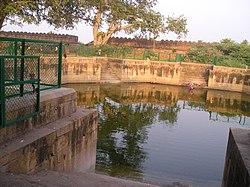Sathyamurthi Perumal Temple
| Sathyamurthi Perumal Temple | |
|---|---|
pudukottai | |
| Deity | |
| Location | |
| Location | Tamil Nadu, India |
| State | Tamil Nadu |
| Country | India |
| Geographic coordinates | 10°14′49″N 78°45′07″E / 10.246945°N 78.751996°E |
| Architecture | |
| Type | Dravidian architecture, rock-cut architecture |
Sathyamurthi Perumal Temple in
The temple is believed to have been built during the 9th century by the
The temple is maintained and administered by the
Legend
The
As per another legend, a sage named Satya performed penance at this place. Pleased by his devotion, Vishnu granted him a boon that he would appear to the sage whenever he wished. The sage had no wish to move away from river where he was performing the penance. Vishnu converted the river to a Pushkarani, the rock to Meyyam hill and banyan tree to Asvatta tree. The sage performed penance again and wished salvation. Vishnu told him that he would attain salvation at the same time as king Pururava. Vishnu appeared in the form of a boar and created havoc in the kingdom of Pururava. The king chased the boar to the forest where the sage was performing penance. The sage was disturbed and opened the eyes, while the king saw the boar disappeared. Vishnu appeared to grant a vision to both of them. He granted salvation to the sage and directed the king to build a temple at this place, which went on to become the Satyamurthi Perumal temple.[2]
History
Historians believe that the temple was built during the 9th century by the
The fort, the
Architecture

The temple is located in
The temple is adjacent to the Sathyagiriswara Sivan temple, located in the same complex. The temple is maintained and administered by the Archaeological Survey of India as a ticketed monument.[8][9]
Religious significance, Religious practices and festival

Sathyamurthi Perumal temple is revered in
The temple follows the traditions of the
References
- ^ M. S., Ramesh (1993). 108 Vaishnavite Divya Desams: Divya desams in Pandya Nadu. Tirumalai-Tirupati Devasthanam.
- ^ a b c R., Dr. Vijayalakshmy (2001). An introduction to religion and Philosophy - Tévarám and Tivviyappirapantam (1st ed.). Chennai: International Institute of Tamil Studies. pp. 537–9.
- JSTOR 3249518.
- ISBN 9781482834628.
- ^ a b "Thirumayam Rockcut temples". CPR Environment Education centre, Chennai. 2019. Retrieved 14 January 2021.
- ^ Tourist Guide to Tamil Nadu
- ^ 108 Vaishnavite Divya Desams (Vol. 4.Ramesh, M. S. (1996))
- ^ "Alphabetical List of Monuments - Tamil Nadu". Archaeological Survey of India. 2011. Retrieved 9 September 2013.
- ^ "List of ticketed monuments - Tamil Nadu". Archaeological Survey of India. 2011. Retrieved 9 September 2013.
- ^ a b "Sathyamurthi Perumal temple". Dinamalar. 2014. Retrieved 31 May 2014.

